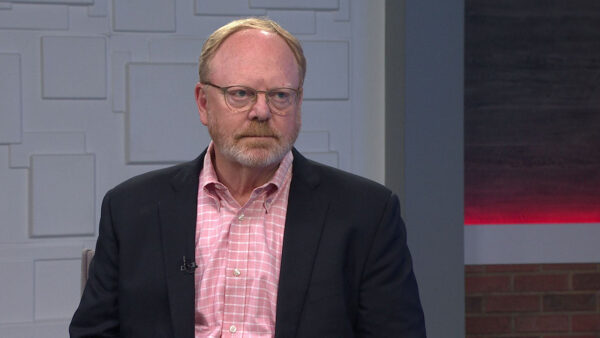“Frontline” will take a look at the heroin problem in America in a special, “Chasing Heroin.” Arizona Horizon will look at the problem in our state with Dr. Cara Christ, the director of the State Department of Health Services.
Ted Simons: Tonight on Arizona PBS, Frontline will look at the heroin problem in America, the program is titled, "Chasing Heroin."
Video: It was like a wave of heroin. A two-hour special report. I lost it all. And it really didn't matter to me. As long as I could get high. Inside an epidemic. I am not putting you in jail. A radical new approach. It's not all seen as a criminal justice problem, or a public health issue. The new face of addiction. I will not let this kill me.
Ted Simons: Here to give us an overview of the heroin problem in Arizona is Dr. Cara Christ, director of the state department of health services. Good to see you.
Cara Christ: Thank you for having us.
Ted Simons: The state of the heroin problem, better or worse or where are we?
Cara Christ: This is a growing epidemic in Arizona. We were ranked in 2014, 15th in the nation for drug overdose deaths.
Ted Simons: So with that in mind, who -- give me the demo here? Who is the classic abuser right now, young, old, male, female, or what are you seeing?
Cara Christ: What we are seeing is middle aged, 45-65-year-olds. And nationally, what we're seeing is that three out of four heroin users, actually, started as an opioid prescription pain medication patient.
Ted Simons: Because of that, and I want to get to that, but is there crossover to younger people because of that medicine cabinet influence?
Cara Christ: We do see that. So, when we look at the statistics, we look mainly at 12 and above, and we see it across the spectrum.
Ted Simons: And you mentioned increased prescription, drug use, and abuse. From what I understand, kids see mom and dad have it in the medicine cabinet, so doctors prescribe it, and it almost has a sheen of kind of acceptance. Kids start, and they get caught, and when they cannot afford the pills any more here comes street heroin, is that the diagram?
Cara Christ: Yes, so that's the story that we're hearing, all across the spectrum, so people get started on opioid pain prescription medication, and it becomes difficult to get, and it's cheaper and easier to get heroin than it is to get an opioid pain medication.
Ted Simons: Are those medications -- you think those are being overprescribed? Have they been overprescribed?
Cara Christ: We've been looking, I think, that there is an appropriate use for opioid pain medication. We are working with providers to try and teach them how to appropriately prescribe for acute and chronic pain.
Ted Simons: I was going to say there is some discussion that adults, just, are simply being overmedicated.
Cara Christ: Enough prescription pain medication was given last year to medicate every adult in Maricopa County around the clock for two weeks.
Ted Simons: My goodness. The heroin, where is it coming -- this is low-cost heroin from Mexico, I would imagine?
Cara Christ: It could be from a number of places. I think that the majority of that does come from Mexico. But, it can come from anywhere.
Ted Simons: And the special Cronkite News ran, and all the other stations, we ran this special, very well done. It seemed like the theme was, kids, everyone saying, if I want it, I can get it. I know how to get it. I know where to get it. No problem. Does that still exist?
Cara Christ: We hear it is easier to get heroin than it is to get the prescription pain medications, especially with the controls placed on it.
Ted Simons: And as easy as other drugs?
Cara Christ: Probably as easy as other drugs, yes.
Ted Simons: So, really, it does not sound like anything is getting better. As far as Arizona is concerned, compared to other regions, how are we doing?
Cara Christ: I think that nation-wide, we are all seeing this trend, and I think that it takes an entire community to respond, so you are going to need not only public health, but, we have got a very strong law enforcement component. The governor's office is extremely involved in this initiative, and this has become a priority for the state.
Ted Simons: And treatment options, what's out there?
Cara Christ: So, there are multiple treatment options. Really, what we're trying to do is one, limit the prescriptions, so that we avoid getting people addicted, and getting people into appropriate therapy, which is medication-assisted along with the behavioral or the counseling component, and trying to get people to prevent death, so getting Naloxone into the places we suspect that there may be overdoses.
Ted Simons: And Naloxone is?
Cara Christ: It is a reversal drug. If somebody has overdosed and has stopped breathing, this will revive them within like 30 seconds to 60 seconds. And it will reverse them along enough to get them to medical treatment.
Ted Simons: And some of these treatment options, have they increased over the years? Are we seeing more of them? Is there more funding needed?
Cara Christ: So it's really getting the appropriate resources to the available areas. So, we know that we have got a provider shortage. We are a mental health professional shortage area, so we have got to expand our treatment availability. We do have to get Naloxone to the hands of the people responding, so our first responders are law enforcement and EMT can carry it, but we're also trying to get it to the loved ones.
Ted Simons: As far as addicted, addicting drugs, though, and I know that heroin is a big deal, and obviously, it's -- what we're talking about, but is meth still the most commonly used drug out there, as far as addicted drugs and dangerous drugs? That you see? Go ahead.
Cara Christ: Heroin is the one that we're seeing, the biggest increase especially with the devastating outcome. I am not sure where meth fits on the level of drugs.
Ted Simons: You hear about meth and alcohol being the most common addiction, and I guess that would hold true.
Cara Christ: That would.
Ted Simons: But, for -- I mean, a lot of folks, they go, what? I don't know anything about this, what's this all about? Is it under the radar to some extent?
Cara Christ: I think it's getting brought more into attention, and I think for a while, it had gone under the radar but over the pastor few years, the actual, in Arizona, one person dies from a prescription drug overdose, per day. And so, it's killing more people than motor vehicle accidents do, so I think it's gaining more attention.
Ted Simons: Ok, so the attention, obviously, from the Frontline special tonight, what we saw last year, with that, the major special, what do people need to know and what's the message here?
Cara Christ: So, people need to know that opioid pain prescription medications are highly addictive, and heroin is one of the most addictive drugs that we can get into. And so, if you are using them, use them carefully. They do have a risk of overdose and death.
Ted Simons: And understand the ramifications.
Cara Christ: Understand the ramifications, and keep them out of the hands of children or people who may not -- they should not have access to it, if it's not their prescription.
Ted Simons: All right. Good to have you here and thanks for joining us.
Cara Christ: Thank you.
Dr. Cara Christ :The director of the State Department of Health Services.























